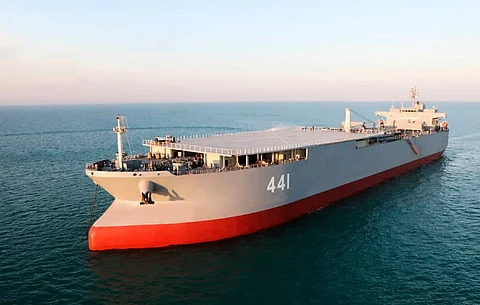

Years of international sanctions against Iran have obliged the nation's maritime force providers to engage in large-scale reverse engineering. A wide range of foreign vessels and weapon systems have been reproduced, in extensively modified form, for Iranian service.
Asset numbers are a vital element of Iranian asymmetrical warfare doctrine. Another feature, therefore, of the relentless expansion (older vessels are seldom retired) of Iranian sea forces has been the adaptation of existing platforms for new roles, such the fitting of support vessels, and even a former presidential yacht, with anti-shipping cruise missiles (ASCM).
A tranche of very recent additions to the Islamic Republic of Iran Navy's (IRIN) order of battle adequately illustrates Iran's parallel policies of reverse engineering and adaptation.
The 40,000-tonne, 228-metre forward base ship Makran, which reports indicate is probably a conversion of the Chinese-built, Maltese-registered bulker Persian Gulf, has been at sea since late December 2020. The IRIN probably envisages the ship primarily as a force multiplier and range extender.
According to an IRIN spokesperson, Makran offers the following capabilities:
Makran features upper deck holding racks for small craft and has been observed operating Sea King, Sea Stallion and AB 212 helicopters and Pelican drones from a large forward flight deck.
The ship bears a superficial resemblance to the US Navy's Expeditionary Sea Base (ESB) ships but lacks the ESB's lower utility deck, which is used for the stowage and launching of landing craft and special forces' boats as well as the transfer of stores.
Like the ESBs, Makran lacks fixed defensive armament and is apparently not intended to go into harm's way.
The conversion reportedly only took about two months, so it is probable that the ship retains some fuel storage and transportation capability. It is therefore conceivable that another role could be support of the regular long-range deployments undertaken by IRIN frigates. These deployments are currently usually supported by the aging, defect-plagued British-built tanker Kharg.
Another factor could be IRIN determination not to be outdone by its sister service, the Islamic Revolutionary Guard Corps Navy, which recently commissioned the 150 -metre support ship Shahid Roudaki.
Active at sea – although probably for political reasons, it has yet to be formally commissioned – is the diesel engine-powered frigate Dena, constructed by the Shahid Darvishi yard near Bandar Abbas. Dena, the latest example of the Mowj-class, is built to a design which was reverse-engineered from the 1970s-vintage, British-built Alvand-class ships, three of which continue to serve with IRIN.
Heavily armed like its sister ships, Dena boasts a weapons outfit consisting of a 76-millimetre gun, a 40-millimetre gun, two 20-millimetre cannon, two machine guns, Qader anti-ship cruise missiles (ASCMs), Sayyad air defence missiles, and two triple anti-submarine torpedo tubes. There is also a helicopter flight deck, but no hangar.
Surprisingly, the new frigate is not equipped with the modern, indigenous Kamand close-in weapon system, which is fitted to its immediate predecessor, Sahand, and to some of the Alvand class.
The main radar system is the ASR 3D phased array radar. This is a passive, electronically scanned system, which is relatively invulnerable to attack by anti-radar missiles designed to generally home in on an emitted radar signature.
This latest addition to the IRIN escort inventory means that the service now has at least eight missile-armed frigates in service, and another Mowj-class ship is known to be in build. The status of the Caspian-based Damavand, which was severely damaged in a grounding in 2018, remains uncertain.
Although the waters of the Middle East are frequently subject to mining by combatant nations and militant armed regional movements, the IRIN is currently very short of mine countermeasures capability. Due shortly to join the fleet, though, is Saba, an indigenously-constructed catamaran surface effect ship, reportedly intended for use as a minehunter or minesweeper. Analysts believe that the 35-metre ship, which was built by Shahid Darvishi, is probably based on a North Korean missile craft design.
If Saba proves to be successful, significant numbers will probably be built to provide the IRIN with a much-needed capability.
